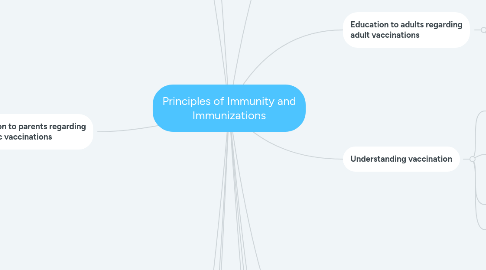
1. Individuals ineligible for vaccination
1.1. Infants under 6 months (for some vaccines)
1.2. If you have an allergy to the vaccine's components or an allergy to eggs, chicken protein or gelatin your risk should be carefully assessed
1.2.1. May be a candidate for intranasal influenza vaccine if allergic to eggs
1.3. Immunocompromised individuals
1.3.1. Cancer patients undergoing chemotherapy
1.3.2. HIV/AIDS patients
1.3.3. Patients taking certain biologic medications for autoimmune conditions
1.4. Pregnant women (for some vaccines)
2. Herd Immunity
2.1. What is it?
2.1.1. "When a large percentage of a population has been vaccinated for disease prevention the chances of getting infected are minimal. Even if 10% of the population does not get vaccinated they have a lower chance of being infected due to majority of the population being vaccinated."
2.2. Who is at risk?
2.2.1. Individuals with contraindications with receiving vaccines
2.2.1.1. Immunocompromised individuals
2.2.1.2. Pregnant women (for certain vaccines)
2.2.1.3. Individuals with allergies to various vaccine components or preservatives
2.2.1.4. Infants under 6 months (for certain vaccines)
2.2.2. Individuals who choose not to get vaccinated
2.2.3. Individuals that are unaware/ uneducated of importance of vaccines
2.2.4. Individuals who do not have access to healthcare
2.3. Consequences of reduced herd immunity
2.3.1. Vulnerable individuals are at risk for contracting deadly illnesses
2.3.2. Outbreaks of serious vaccine-preventable illness in a geographic region
2.3.3. Higher incidence of hospital admissions
2.3.4. Rising healthcare costs related to greater disease burden
2.3.5. Higher death tolls among the elderly, the vulnerable, and young children
3. Education to parents regarding pediatric vaccinations
3.1. How do germs make your baby sick? | How Vaccines Work
3.2. Preparing for the vaccine visit
3.2.1. Plan ahead
3.2.1.1. Provide educational hand-outs prior to the vaccine visit
3.2.1.2. Provide links to educational videos from the CDC and WHO
3.2.2. Provide tips on making shots less stressful
3.2.2.1. Distraction
3.2.2.2. Play
3.2.2.3. Comfort
3.2.2.4. Breastfeeding
3.2.2.5. Sweets and treats
3.2.2.6. Remain calm
3.2.2.7. Bring a favorite toy
3.3. Making the vaccine decision
3.3.1. Education regarding vaccine ingredients
3.3.2. Factual vs. Misinformation
3.3.2.1. Vaccines do not cause autism: the misinformation of Andrew Wakefield
3.3.2.1.1. Scientific research has shown no evidence of connection between thimerosal and autism
3.3.2.2. Providing patients with safety information from the CDC
3.3.2.3. Thimerosal safety
3.3.2.3.1. Thimerosal prevents the growth of bacteria in vaccines
3.3.2.3.2. The human body eliminates thimerosal easily
3.3.2.3.3. The most common side effect of thimerosal is mild swelling and redness at the injection site
3.3.2.4. Vaccine preservatives serve a purpose and are safe
3.3.3. Safety and development of vaccines
3.3.3.1. The Journey of Your Child’s Vaccine
3.3.4. Importance of preventing disease: a parent's responsibility
3.3.5. Strengthening your baby's immune system
3.3.6. Understanding the risks and dangers of not vaccinating or not vaccinating on time
3.3.7. Recommended vaccine schedules
3.3.7.1. Delayed vaccination schedules put children at risk for developing serious and deadly disease due to an underdeveloped immune system
3.3.7.2. Vaccine schedules are developed based on when a child loses passive immunity from his or her mother
3.3.7.3. Vaccine schedules are designed to build and boost immunity from an early age
3.3.7.4. Multiple vaccinations do not cause harm to a child
3.3.7.5. Reduced vaccination = increased exposure and disease risk
4. Common vaccine-preventable illnesses
4.1. diphtheria
4.2. tetanus
4.3. pertussis (whooping cough)
4.4. poliomyelitis (polio)
4.5. measles
4.6. mumps
4.7. rubella
4.8. haemophilus influenzae type b infections
4.9. hepatitis B
4.10. influenza
4.11. pneumococcal infections
4.12. MMR
4.13. Polio
4.14. Smallpox
4.15. Tetanus
4.16. Chickenpox
5. Live (attenuated) vaccines
5.1. "Modified Live Vaccine"
5.1.1. Influenza (Intranasal)
5.1.2. MMR
5.1.3. Oral Poliovirus
5.1.4. Rotavirus
5.1.5. Varicella
5.1.6. Zoster
5.1.7. Oral Typhoid
5.1.8. Yellow Fever
5.1.9. Bacillus Calmette- Guerin
6. Passive immunity
6.1. It is the transfer of active humoral immunity of ready-made antibodies
6.2. Can occur naturally, when maternal antibodies are transferred to the fetus through the placenta
6.3. It can also be induced artificially, when high levels of antibodies specific to a pathogen or toxin are transferred to non-immune persons through blood products that contain antibodies, such as in immunoglobulin therapy or antiserum therapy
7. Understanding vaccination
7.1. Vaccines help the body build immunity by imitating an infection
7.2. Vaccines almost never cause true illness
7.2.1. Understanding the difference between illness and an immune response
7.2.1.1. https://www.cdc.gov/vaccines/hcp/conversations/downloads/vacsafe-understand-color-office.pdf
7.2.1.2. May experience mild symptoms like fever, muscle soreness, or mild URI symptoms
7.2.1.3. "Imitation" infection
7.2.1.3.1. The "imitation" infection is important to help the body build immunity
7.3. Development of memory T-lymphocytes and B-lymphocytes
7.4. Memory white blood cells remember how to fight disease in the future
8. What is immunity?
8.1. Innate immunity
8.1.1. non-specific
8.1.1.1. includes skin, digestive enzymes with acids, sneezing, coughing, cilia, tears, and other physical barriers
8.2. Adaptive immunity
8.2.1. the ability of an organism to resist a particular infection or toxin by the action of specific antibodies or sensitized white blood cells
8.2.1.1. Cell-mediated
8.2.1.1.1. carried out by T-cells
8.2.1.2. Humoral
8.2.1.2.1. carried out by antibodies
9. Education to adults regarding adult vaccinations
9.1. The CDC has great resources for vaccines that you can print out and give to patients
9.1.1. Resources for Educating Adult Patients about Vaccines | CDCMinushomeexpandexpandexpandexpand file_external
10. Inactivated Vaccines
10.1. "Killed or Dead Vaccine"
10.1.1. Diptheria, Tetanus, Acellular Pertussis
10.1.2. Haemophilus B Conjugate
10.1.3. Inactivated Poliovirus
10.1.4. Hepatitis A & B
10.1.5. HPV
10.1.6. Influenza
10.1.7. Pneumococcal
10.1.8. Meningococcal
10.1.9. Lyme Disease
10.1.10. Typhoid
10.1.11. Cholera
10.1.12. Japanese Encephalitis Virus
10.1.13. Rabies
11. Active immunity
11.1. The induction of immunity after exposure to an antigen.
11.2. Antibodies are created by the recipient and may be stored permanently
12. Vaccines for Children program
12.1. Available for children who are under the age of 18 and met one of the following criteria:
12.1.1. Medicaid eligible
12.1.2. Uninsured
12.1.3. American Indian or Native Alaskan
12.1.4. Underinsured
